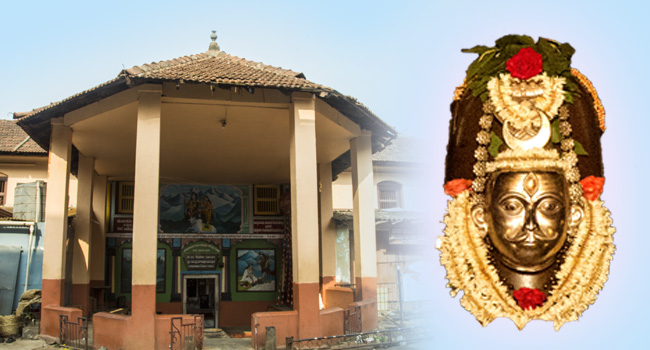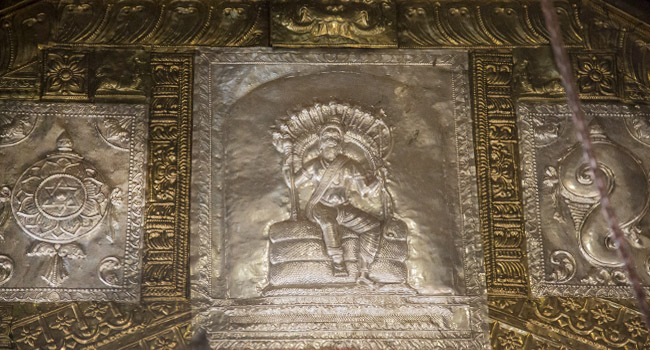History
-
Puranic background / ಪೌರಾಣಿಕ ಹಿನ್ನಲೆ

Legend has it that Acharya Madhwa’s father was a priest at Sri Ananteshwara temple. When he shifted to Pajaka, a tiny village near Udupi, he carried an idol of Anantapadmanabha with him, installed it there and the deity is worshipped to this day. This is one of the evidences to show that Lord Vishnu was worshipped here even before Acharya’s emergence. Madhwa Vijaya categorically states that Acharya Madhwa was born here as a reward to the worship offered to Sri Anantapadmanabha by the Nadillaya couple and as a fulfilment of the vow taken by them. Originally, this temple was called Padu Devalaya to distinguish it from Moodu Devalaya mentioned earlier. The deity worshipped here is referred to as Mahadeva of Padu Devalaya in ancient inscriptions. It was on the premises of this temple that Acharya Madhwa taught the Holy Scriptures to his disciples. Madhwa Vijaya states in no uncertain terms that when the great scholar-saint was teaching them Aitareya Upanishat, the skies opened up with rains of flowers. Even now, worship is offered to the granite slab on which Acharya Madhwa sat while teaching his students. No idol is placed on the slab. Sri Vadiraja affirms that Acharya Madhwa is still invisibly present on the slab. The architecture of the temple bears unmistakable testimony to its antiquity. The temple sanctuary that bears the shape of the back of the elephant (Gajaprushtha) offers clinching proof in this regard. ಆಚಾರ್ಯ ಮಧ್ವರ ತಂದೆ ಶ್ರೀ ಅನಂತೇಶ್ವರ ದೇವಸ್ಥಾನದಲ್ಲಿ ಅರ್ಚಕರಾಗಿದ್ದರು ಎಂದು ಐತಿಹ್ಯ. ಅವರು ಇಲ್ಲಿಂದ ಪಾಜಕಕ್ಕೆ ಹೋಗಿ ನೆಲೆಸಿದಾಗ, ಈ ಅಧಿದೇವತೆಯ ನೆನಪಿಗಾಗಿ ಒಂದು ಅನಂತಪದ್ಮನಾಭನ ಪ್ರತೀಕವನ್ನು ತಮ್ಮ ಉಪಾಸನೆಗಾಗಿ ತಂದಿಟ್ಟುಕೊಂಡರು. ಆ ವಿಗ್ರಹವು ಈಗಲೂ ಪಾಜಕದಲ್ಲಿ ಪೂಜೆಗೊಳ್ಳುತ್ತಿದೆ. ಆಚಾರ್ಯರ ಪೂರ್ವದಲ್ಲೇ ಅಲ್ಲಿ ವಿಷ್ಣುವಿನ ಆರಾಧನೆ ನಡೆಯುತ್ತಿತ್ತು ಎನ್ನುವುದಕ್ಕೆ ಇದೂ ಒಂದು ಸಾಕ್ಷಿ. ಈ ಅಧಿದೈವದ ಸೇವೆಯನ್ನು ನಡಿಲ್ಲಾಯ ದಂಪತಿಗಳು ಹರಕೆ ಹೊತ್ತು ನಡೆಸಿದ ಫಲವಾಗಿಯೆ ಆಚಾರ್ಯ ಮಧ್ವರ ಅವತಾರವಾಯಿತು ಎಂದು “ಮಧ್ವವಿಜಯ” ಹೇಳುತ್ತದೆ. ಈ ದೇವಾಲಯದ ಪ್ರಾಚೀನ ಹೆಸರು ಪಡು ದೇವಾಲಯ. ಪಡು ದೇವಾಲಯದ ಮಹಾದೇವರು ಎಂದು ಪ್ರಾಚೀನ ಶಾಸನಗಳಲ್ಲಿ ಉಲ್ಲೇಖವಿದೆ. ಅದರ ಪೂರ್ವದಲ್ಲಿರುವ ಚಂದ್ರಮೌಳೀಶ್ವರನ ಮಂದಿರವೇ ಮೂಡು ದೇವಾಲಯ. ಆಚಾರ್ಯ ಮಧ್ವರು ತಮ್ಮ ಶಿಷ್ಯರಿಗೆ ಪ್ರವಚನ ನಡೆಸುತ್ತಿದ್ದದ್ದು ಈ ದೇವಾಲಯದ ಒಳ ಆವರಣದಲ್ಲಿಯೇ. ಆಚಾರ್ಯರು ಇಲ್ಲಿ ಐತರೇಯ ಉಪನಿಷತ್ ಪ್ರವಚನ ಮಾಡುತ್ತಿದ್ದಾಗ, ಮುಗಿಲಿನಿಂದ ಪುಷ್ಪವೃಷ್ಟಿಯಾದ ಪ್ರಸಂಗವನ್ನು ಮಧ್ವವಿಜಯ ಉಲ್ಲೇಖಿಸುತ್ತದೆ. ಆಚಾರ್ಯರು ಪ್ರವಚನ ಮಾಡುವಾಗ ಕೂಡುತ್ತಿದ್ದ ಶಿಲಾಫಲಕ ಈಗಲೂ ಅಲ್ಲಿ ಪೂಜೆಗೊಳ್ಳುತ್ತಿದೆ. ಆ ಫಲಕದ ಮೇಲೆ ಬೇರೆ ವಿಗ್ರಹವಿಲ್ಲ. ಶಿಲಾಫಲಕದಲ್ಲಿ ಆಚಾರ್ಯ ಮಧ್ವರು ಸದಾ ಸನ್ನಿಹಿತರಾಗಿದ್ದಾರೆ ಎಂದು ಶ್ರೀ ವಾದಿರಾಜರು ಬಣ್ಣಿಸಿದ್ದಾರೆ. ಈ ದೇವಾಲಯದ ವಾಸ್ತುವೂ ಇದರ ಪ್ರಾಚೀನತೆಗೆ ಸಾಕ್ಷಿ. ಗಜಪೃಷ್ಠಾಕಾರದ ಗರ್ಭ ಗೃಹ ಇದರ ಪ್ರಾಚೀನತೆಯನ್ನು ಸಾರುತ್ತದೆ.
Brief on Kshetra / ಕ್ಷೇತ್ರ ಪರಿಚಯ

Adjacent to Sri Ananteshwara temple, a tiny shrine dedicated to Sri Chandramauleeshwhara is situated in the east. Even though it is an ancient temple, no historical details are available about this temple. One of the popular legends related to this temple holds that cluster of trees called “Abjaranya” (the present Poornaprajna College campus) was existing at half-a-Kilo Metres from the present Car Street of Udupi. There was a small pond nearby. People believe that demigod Moon did penance in this spot and got himself relieved from a curse. That is why, the place came to be called as Abjaranya. Immensely pleased with the Moon’s penance, Lord Shiva appeared before him and granted his wish. Chandramauleshwara temple surfaced in order to commemorate this event. Chandramauleshwhara temple is small in size when compared to the neighboring Ananteshwara temple. The literary work Madhwa Vijaya mentions that the temple was being called Moodu Devalaya (Mahendradigalaya) as it lies to the east (moodu) of Sri Ananteshwara temple, which is considered to be the main shrine of the place. Even to this day, the prospective Paryaya Swamiji first pays obeisance to Lord Chandramauleshwara and then to Lord Ananteshwara and later, he visits Sri Krishna Mutt, before ascending the Paryaya Peetha. ಶ್ರೀ ಅನಂತೇಶ್ವರ ದೇವರ ಎದುರುಗಡೆ, ಪೂರ್ವದಿಕ್ಕಿನಲ್ಲಿರುವ ಪುಟ್ಟ ದೇವಸ್ಥಾನವು. ಪುರಾತನವಾದರೂ ಇದರ ಬಗ್ಗೆ ಹೆಚ್ಚಿನ ಐತಿಹಾಸಿಕ ವಿವರಗಳು ದೊರೆತಿಲ್ಲ. ಬಳಕೆಯಲ್ಲಿರುವ ಒಂದು ಐತಿಹ್ಯ ಹೀಗಿದೆ. ಉಡುಪಿಯ ಕೇಂದ್ರದಿಂದ ಸುಮಾರು ಅರ್ಧ ಕಿ.ಮೀ. ದೂರದಲ್ಲಿ ಅಬ್ಜಾರಣ್ಯ(ಪ್ರಸ್ತುತ ಪೂರ್ಣಪ್ರಜ್ಞ ಕಾಲೇಜು) ಎಂಬ ಬನವೊಂದಿತ್ತು. ಅಲ್ಲಿ ಒಂದು ಪುಷ್ಕರಣಿಯೂ ಇದೆ. ಇಲ್ಲಿ ಚಂದ್ರ ತಪಸ್ಸು ಮಾಡಿದನಂತೆ. ಅದಕ್ಕೆಂದೇ ಈ ಸ್ಥಳಕ್ಕೆ ಅಬ್ಜಾರಣ್ಯ ಎಂದು ಹೆಸರಿಸಲಾಯಿತಂತೆ. ಚಂದ್ರನ ತಪಸ್ಸಿಗೆ ಮೆಚ್ಚಿ ಒಲಿದ ಶಿವ ತಾಣವೇ ಚಂದ್ರಮೌಳೀಶ್ವರನ ದೇವಾಲಯ. ಹೀಗೆಂದು ಒಂದು ನಂಬಿಕೆ ಇಲ್ಲಿ ಪ್ರಚಲಿತವಾಗಿದೆ. ಚಂದ್ರಮೌಳೀಶ್ವರ ದೇವಾಲಯವು ಗಾತ್ರದಲ್ಲಿ ಅನಂತೇಶ್ವರ ದೇವಸ್ಥಾನಕ್ಕಿಂತ ಚಿಕ್ಕದು. ಹಿಂದಿನ ಕಾಲದಲ್ಲಿ ಈ ದೇವಸ್ಥಾನವನ್ನು “ಮೂಡು ದೇವಾಲಯ” (ಮಹೇಂದ್ರ ದಿಗಾಲಯ) ಎಂದು ಕರೆಯುತ್ತಿದ್ದರು ಎಂದು ಮಧ್ವವಿಜಯದಿಂದ ತಿಳಿದುಬರುತ್ತದೆ. ಗ್ರಾಮದ ಪ್ರಧಾನ ದೇವಸ್ಥಾನವಾಗಿದ್ದ ಶ್ರೀ ಅನಂತೇಶ್ವರಕ್ಕಿಂತ ಮೂಡು ದಿಕ್ಕಿನಲ್ಲಿರುವುದರಿಂದ ಈ ಹೆಸರು ಬಂದಿದೆ. ಇಂದಿಗೂ ಪರ್ಯಾಯಕ್ಕೆ ಕೂಡುವ ಸ್ವಾಮಿಗಳು, ಪರ್ಯಾಯಕ್ಕೆ ಕೂಡುವ ಮುನ್ನ ಚಂದ್ರಮೌಳೀಶ್ವರನ ದರ್ಶನ ಮಾಡಿ ಅನಂತರ ಶ್ರೀ ಅನಂತಾಸನ ಸಂದರ್ಶನ, ನಂತರ ಶ್ರೀಕೃಷ್ಣ ದರ್ಶನ ಮಾಡುವ ಸಂಪ್ರದಾಯ ನಡೆದುಬಂದಿದೆ.
Madhvacharya and Ananteshwara / ಮಧ್ವಾಚಾರ್ಯ ಮತ್ತು ಅನಂತೇಶ್ವರ

Legend has it that Acharya Madhwa’s father served here as the temple priest. When he shifted to the holy Pajaka kshetra, he carried a replica of Lord Ananthapadmanabha’s idol with him and installed it at Pajaka where it is worshipped to this day. This is one of the evidences to prove that Lord Vishnu was worshipped here even before Acharya’s days. Madhwa Vijaya states categorically that Acharya Madhwa incarnated here as a reward to the Nadillaya couple who worshipped this deity with overwhelming devotion and as a fulfilment of the vow taken by them. Originally this temple was called Padudevalaya to distinguish it from Moodudevalaya mentioned earlier. The deity worshipped here is referred to as Mahadeva of Padudevalaya in ancient inscriptions. It was on the premises of this temple that Acharya Madhwa taught the Holy Scriptures to his disciples. Madhwa Vijaya states in no uncertain terms that when the great scholar-saint was teaching them Aitareya Upanishat, the skies opened up with rains of flowers. Even now worship is offered to the granite slab on which Acharya Madhwa sat invariably while teaching his students. No idol is placed on the slab. Sri Vadiraja affirms that Acharya Madhwa is still invisibly present on the slab. The architecture of the temple bears unmistakable testimony to its antiquity. The temple sanctuary that bears the shape of the back of the elephant (Gajaprushtha) offers clinching proof in this regard. ಆಚಾರ್ಯ ಮಧ್ವರ ತಂದೆ ಈ ದೇವಸ್ಥಾನದ ಅರ್ಚಕರಾಗಿದ್ದರು ಎಂದು ಐತಿಹ್ಯ. ಅವರು ಇಲ್ಲಿಂದ ಪಾಜಕಕ್ಕೆ ಹೋಗಿ ನೆಲೆಸಿದಾಗ ಈ ಅಧಿದೇವತೆಯ ನೆನಪಿಗಾಗಿ ಒಂದು ಅನಂತ ಪದ್ಮನಾಭನ ಪ್ರತೀಕವನ್ನು ತಮ್ಮ ಉಪಾಸನೆಗಾಗಿ ತಂದಿಟ್ಟುಕೊಂಡರು. ಆ ವಿಗ್ರಹವು ಈಗಲೂ ಅಲ್ಲಿ ಪೂಜೆಗೊಳ್ಳುತ್ತಿದೆ. ಆಚಾರ್ಯರ ಪೂರ್ವದಲ್ಲೇ ಅಲ್ಲಿ ವಿಷ್ಣುವಿನ ಆರಾಧನೆ ನಡೆಯುತ್ತಿತ್ತು ಎನ್ನುವುದಕ್ಕೆ ಇದೂ ಒಂದು ಸಾಕ್ಷಿ. ಈ ಅಧಿದೈವತದ ಸೇವೆಯನ್ನು ನಡಿಲ್ಲಾಯ ದಂಪತಿಗಳು ಹರಕೆಹೊತ್ತು ನಡೆಸಿದ ಫಲವಾಗಿಯೆ ಆಚಾರ್ಯ ಮಧ್ವರ ಅವತಾರವಾಯಿತು ಎಂದು “ಮಧ್ವವಿಜಯ” ಹೇಳುತ್ತದೆ. ಈ ದೇವಾಲಯದ ಪ್ರಾಚೀನ ಹೆಸರು ಪಡು ದೇವಾಲಯ. ಪಡು ದೇವಾಲಯದ ಮಹಾದೇವರು ಎಂದು ಪ್ರಾಚೀನ ಶಾಸನಗಳಲ್ಲಿ ಉಲ್ಲೇಖವಿದೆ. ಅದರ ಪೂರ್ವದಲ್ಲಿರುವ ಚಂದ್ರಮೌಳೀಶ್ವರನ ಮಂದಿರವೇ ಮೂಡು ದೇವಾಲಯ. ಆಚಾರ್ಯ ಮಧ್ವರು ತನ್ನ ಶಿಷ್ಯರಿಗೆ ಪ್ರವಚನ ನಡೆಸುತ್ತಿದ್ದದ್ದು ಈ ದೇವಾಲಯದ ಒಳ ಆವರಣದಲ್ಲಿಯೇ. ಆಚಾರ್ಯರು ಇಲ್ಲಿ ಐತರೇಯ ಪ್ರವಚನ ಮಾಡುತ್ತಿದ್ದಾಗ ಮುಗಿಲಿನಿಂದ ಪುಷ್ಪವೃಷ್ಟಿಯಾದ ಪ್ರಸಂಗವನ್ನು ಮಧ್ವವಿಜಯ ಉಲ್ಲೇಖಿಸುತ್ತದೆ. ಆಚಾರ್ಯರು ಪ್ರವಚನ ಮಾಡುವಾಗ ಕೂಡುತ್ತಿದ್ದ ಶಿಲಾಫಲಕ ಈಗಲೂ ಅಲ್ಲಿ ಪೂಜೆಗೊಳ್ಳುತ್ತಿದೆ. ಆ ಫಲಕದ ಮೇಲೆ ಬೇರೆ ವಿಗ್ರಹವಿಲ್ಲ. ಶಿಲಾಫಲಕಕ್ಕೆ ಪೂಜೆ. ಅದರಲ್ಲಿ ಆಚಾರ್ಯ ಮಧ್ವರು ಸದಾ ಸನ್ನಿಹಿತರಾಗಿದ್ದಾರೆ ಎಂದು ಶ್ರೀ ವಾದಿರಾಜರು ಬಣ್ಣಿಸಿದ್ದಾರೆ. ಈ ದೇವಾಲಯದ ವಾಸ್ತುವೂ ಇದರ ಪ್ರಾಚೀನತೆಗೆ ಸಾಕ್ಷಿ. ಗಜಪೃಷ್ಠಾಕಾರದ ಗರ್ಭ ಗೃಹ ಇದರ ಪುರಾತನತೆಯನ್ನು ಸಾರುತ್ತದೆ.



